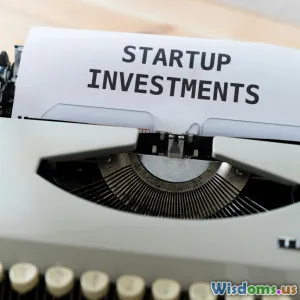
Are Pitch Deck Mistakes Costing You Potential Investors
15 min read Discover how common pitch deck mistakes can hinder your fundraising efforts and learn actionable tips to enhance investor appeal. (0 Reviews)
Are Pitch Deck Mistakes Costing You Potential Investors?
Securing the attention—and funding—of an investor starts long before the boardroom handshake. Your pitch deck is your company’s first impression, the business card to your entrepreneurial vision. In the high-stakes world of startup funding, even small mistakes can derail your narrative, erode credibility, and send potential investors packing. Yet, many founders stumble over surprisingly avoidable errors that turn their big break into a near miss. It's time to uncover these pitfalls, learn from the failures (and triumphs) of others, and craft pitch decks that spark genuine investor interest.
The First Minutes Matter: Crafting a Magnetic Opening

The first minutes of any presentation set the tone—and pitch decks are no exception. Studies from Harvard Business School reveal that investors often make up their minds about a team within five minutes of a pitch meeting. A magnetic opening can mean the difference between leaning in and tuning out.
You have only a few slides—and even fewer words—to establish your unique value proposition and story. Take Airbnb, for instance: their original pitch deck famously opened with, “Book rooms with locals, rather than hotels.” Simple, clear, and impactful.
Actionable Tips:
- Start with a Compelling Problem: Address a pain point that investors can instantly grasp. E.g., "Every year, travelers overpay $500 million for subpar lodging."
- Show Your Uniqueness: Immediately clarify how your business offers a solution no one else does.
- Avoid Generic Openings: Phrases like "We're passionate about [industry]" are overused and forgettable.
Common Mistake: Starting too broad or theoretical. Lead clear, fast, and with confidence.
Clarity Beats Complexity: Simplifying Your Message

Complex, jargon-filled decks are a quick way to lose your audience. Investors aren’t evaluating academic research—they want to quickly understand your business model, product, and how you plan to win the market. Dropbox’s legendary pitch deck distilled technical cloud storage into three ultra-clear slides.
Actionable Advice:
- Use Simple Language: Treat your slides as if explaining your startup to a high schooler. If it can’t be explained simply, refine your pitch.
- Limit Text: Decks are visual aids, not white papers. Convey ideas with concise statements and visuals.
- Avoid Technical Overload: Save deep technical explanations for later Q&A. In the deck, emphasize value, not minute features.
Real-World Example: Snapchat succeeded by plainly describing their product’s appeal: “Sharing moments with friends—easier and more fun.”
The Story Matters: Designing a Narrative Arc

Pitch decks should do more than list facts and figures—they should tell a story that urges investors to root for you. According to a Stanford GSB study, investors connect more with story-driven pitches, translating into greater funding interest.
How-To Build a Strong Narrative:
- Introduce the Hero and Problem: Who is affected by the issue you’re solving, and how is their world improved by your solution?
- Obstacle and Resolution: Present the challenges and how your company uniquely overcomes them.
- Call to Action: Show investors the next chapter—and how they can join.
Mistake to Avoid: Information overload without context, which numbs prospects. Instead, anchor data points to human impact. When Watson, an AI HR tool, wove real client stories into its deck, investor interest doubled. Your narrative should be the thread connecting all slides, from problem to ask.
Data That Drives Decisions: Financials and KPIs

Investors want evidence. Well-presented, relevant, and believable data can build trust and demonstrate traction. Omitting or poorly explaining key metrics such as growth rate, customer acquisition cost (CAC), or lifetime value (LTV) is a frequent founder slip.
Analysis and Tips:
- Be Transparent: List your most vital KPIs, but don’t fudge numbers; experienced investors catch inconsistencies quickly.
- Show Trends and Projections: Static numbers aren’t enough—use charts to highlight growth, wins, or user engagement over time.
- Benchmark Against Peers: Frame your numbers in context; “above-average retention for SaaS in Q1 2024” is better than raw loyalty rates.
Example: Fintech startup Brex used cohort revenue data to showcase user retention over months, emphasizing healthy, repeat business.
Team Slides: Are You Overlooking Star Power?

Investors rarely fund ideas—they back people who execute them. Yet, many founders gloss over their teams with resumes and headshots, leaving out the heart of why this group is uniquely equipped to win.
What Works:
- Highlight Individual Achievements: Did a founder scale a startup to exit? Did your CTO win a prestigious hackathon?
- Complementary Skills: Show how backgrounds mesh—tech, sales, domain, scaling.
- Diversity and Passion: More investors are prioritizing teams with a range of experiences and demonstrated conviction.
Mistake to Dodge: Vague bios like "15 years of experience." Instead, tout outcomes: “Led prior company to $14M ARR.”
Visuals Speak Louder: The Power of Design

Design isn’t just decoration—it’s a signal of seriousness, taste, and user focus. According to DocSend, investors spend just 3 minutes and 44 seconds on average per deck, so clean visuals and brand coherence are critical.
Tips for Maximum Impact:
- Consistent Branding: Use your logo, company colors, and fonts throughout.
- Use Icons and Data Visuals: Replace blocks of text with infographics, icons, and annotated photos wherever possible.
- White Space Isn’t Wasted Space: Cluttered slides confuse; minimalist layouts enhance focus.
Dropbox’s pitch deck is instructive—its clear diagrams and colors echoed product usability and brand ethos. Conversely, cramped, inconsistent slides can undermine even strong concepts.
Honest Asks: Candidly State What You Need

One of the most common—and disastrous—errors is being vague or coy in your funding ask or use-of-proceeds slide. Investors need crystal clarity on both the size of investment requested and how every dollar will fuel growth.
How To Get It Right:
- Be Direct: Specify the amount sought and planned allocation. E.g., “Seeking $2M to accelerate sales, hire engineers, and deepen marketing.”
- Justify Your Ask: Connect fundraising totals and burn rates with achievable milestones. “With $2M, we expand to 100K users by Q2 2025.”
- Avoid Wishful Thinking: Don’t promise impossible timelines, hockey-stick projections, or indefinite runway.
Top venture firms cite unrealistic financial asks as reasons for passing, regardless of product strength.
Know Your Audience: Research Before You Send

Even the brightest pitch falls flat if it lands in the wrong inbox. Tailoring decks to individual or firm-specific interests dramatically increases open rates and responses. According to Crunchbase data, investor relevance is one of the biggest determinants for securing meetings.
Actionable Steps:
- Study Past Investments: Customize your deck to reflect trends in an investor’s portfolio.
- Name Drop Wisely: Reference relevant portfolio companies (“Our go-to-market is similar to [investor-backed SaaS firm]”—shows awareness.)
- Prepare Different Deck Versions: Have a one-pager, teaser, and deep-dive depending on context and recipient.
The worst mistake? Sending boilerplate, scattershot decks; these rarely reach decision-makers and often label you as unprepared.
Timing and Follow-Through: Beyond the Deck

Delivering a pitch deck is just the start—timing and process management are integral to fundraising success. Many founders drop the ball by failing to follow up, misreading investor interest, or sending pitch decks at poorly chosen moments.
Advice to Optimize Results:
- Follow Up Strategically: Space your communications thoughtfully. For warm intros, thank quickly and coordinate next steps. For cold emails, a courteous follow-up a week later can nudge busy VCs.
- Capture Feedback: Constructive critiques are investor gold. If they pass, ask why—then refine your deck for the next pitch.
- Match Fundraising to Milestones: Time raises to critical traction points or company achievements; don't pitch preemptively.
Effectively, the strongest decks fuel ongoing conversations and long-term relationships, not just initial yes-or-no decisions.
Case Studies: When Deck Mistakes Cost—and When They Win

Costly Mistake: In 2016, Juicero raised millions with a beautifully designed deck, but it failed to clarify genuine pain points or competitive edge. Investors later realized the company oversold its "unique" value—leading to massive losses and brand downfall.
Success Example: On the other hand, the early deck for Superhuman (the email client) impressed investors not by feature-dropping, but by vividly detailing user experience and retention stats relative to industry benchmarks. This context made the opportunity—and the team behind it—impossible to ignore.
Lesson Learned: Genuine differentiation, evidence, and tailored narratives almost always win out over style without substance.
Proactive Checklist: Audit Your Deck Before Sending

A few last checks can prevent costly missteps:
- Does each slide support your core story?
- Is your ask direct, justified, and backed by a use-of-proceeds breakdown?
- Have you explained data in context—benchmarks, trends, not just static numbers?
- Are all visuals, fonts, and designs brand-consistent with no typos?
- Is your team slide more than just resumes—does it show unique synergies or wins?
- Is each metric current and presented honestly?
- Have you tailored the narrative or specific slides to each investor audience?
Inviting a trusted advisor or investor with experience to give constructive criticism can reveal blind spots.
Taking Action: Transform Mistakes into Opportunity

In the end, a pitch deck is more than slides—it's your company’s moment to inspire, inform, and incite action. Avoiding common mistakes increases the likelihood of not just interest, but lasting partnerships. Invest the same care and strategy into your deck as you do your product, and investors will notice—and respond.
Every pitch, tailored with insight and clarity, brings you one step closer to finding those who see your startup vision not just as plausible, but inevitable. Start with your next deck, and make every slide count.
Rate the Post
User Reviews
Popular Posts
















